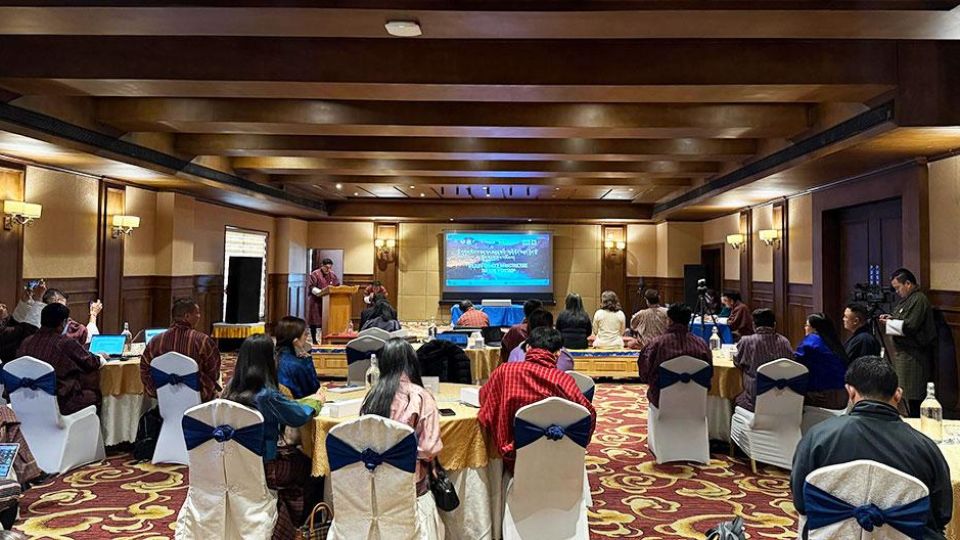March 27, 2025
THIMPHU – As Bhutan accelerates its infrastructure expansion, conservationists and engineers are grappling with a pressing challenge: how to develop without endangering the country’s rich biodiversity.
The USD 2.15 billion Bhutan Highways Connectivity Master Plan, a comprehensive development strategy spearheaded by the Department of Surface Transport (DoST) and supported by the Asian Development Bank (ADB) aims to enhance road connectivity through major projects such as highway expansions, tunnels, bypasses, and bridge replacements.
The Master Plan scheduled for completion by June 2025, these projects pose significant risks to Bhutan’s wildlife and protected areas.
Against this backdrop, a three-day workshop on “Development of Wildlife-Friendly Infrastructure”, organised by the Department of Forests and Park Services in collaboration with the World Wildlife Fund (WWF) Bhutan and the International Union for Conservation of Nature (IUCN), is exploring ways to integrate wildlife-sensitive designs into Bhutan’s infrastructure projects.
More than 35 participants, including engineers, environmental experts, and conservationists from institutions like the World Bank, WWF Bhutan, and the IUCN’s Asian Elephant Transport Working Group, are discussing mitigation strategies. The absence of policymakers, however, raised concerns about the feasibility of implementing these measures. The country director of WWF Bhutan, Chimi Rinzin, said that poorly planned infrastructure can result in habitat fragmentation, increased wildlife mortality, and escalating human-wildlife conflicts. Bhutan, long celebrated for its environmental stewardship, now faces a critical test as it strives to uphold conservation while pursuing economic growth.
“Through such workshops, mindful and responsible development of infrastructure should be enhanced that support the livelihood of the communities without undermining the wildlife species,” he said.
The stakes are particularly high given Bhutan’s ambitious 13th Plan, which aims to transition the country into a high-income economy. This includes the construction of Gelephu Mindfulness City, a megaproject that will require careful planning to coexist with Bhutan’s wildlife, especially its population of 678 Asian elephants, which roam the region.
Sandeep Tiwari, co-chair of the IUCN Asian Elephant Transport Working Group said human-wildlife conflict and pressure between development and wildlife conservation are global challenges.
“The coming up of Gelephu Mindfulness City, which builds synergy between development and proper planning, is crucial to have a linear infrastructure that involves and balances all sectors.”
Bhutan’s road network spans over 18,057 kilometres, classified into various categories, including Asian highways, primary and secondary national highways, dzongkhag roads, urban roads, and farm roads. These roads are under the jurisdiction of various agencies such as Project DANTAK, DoST, dzongkhag and thromdes.
Some of the key projects under the master plan include the Lhamoizingkha-Sarpang Highway, which spans 103.8 kilometres and requires an investment of Nu 9,451 million. The Gelephu-Tareythang Road, covering 14.1 kilometres, is estimated to cost Nu 6,559 million, while the 78.5-kilometre Tareythang-Panbang road connectivity project would require Nu 6,238 million. The Lhamoizingkha-Panbang road link, extending 196.4 kilometres, is expected to need an investment of Nu 22,354 million.
Similarly, the Thimphu-Khariphu-Chuzom road, spanning 24.6 kilometers, would require Nu 2,136 million, while the proposed 12.5 kilometres Khasadrapchu-Shaba tunnel is projected to cost Nu 57,956 million. Additionally, the Thimphu-Khasadrapchu Road, which includes a tunnel and extends 31.7 kilometers, would require a total investment of Nu 58,827 million.
The draft master plan outlines a total investment of USD 2,151 million (Nu 187,718 million) for road development and maintenance. The proposed road connectivity projects have undergone a strategic environmental assessment, considering factors such as wildlife conservation and biodiversity, climate change mitigation and adaptation, water resource management, public safety, equitable development, national economic growth, cultural heritage preservation, sustainable use of natural resources, and pollution control.
Some of the key risks highlighted during the workshop include the loss of forest habitat, habitat degradation and fragmentation, increased wildlife mortality, and escalating human-wildlife conflicts. A major concern was the construction of new highways in protected areas, which could have significant environmental repercussions.
An official from DoST acknowledged the challenges posed by these highways, emphasising that they threaten biodiversity, conflict with existing national laws on protected areas, and necessitate compensatory measures to mitigate their impact.
The plan also emphasises eco-tourism development and anti-poaching measures as key benefits.
“Aligning with the demands of the Paris Agreement, 44 slope failure mitigation projects, 40 bridge replacements, and two tunnels will be developed,” according to the master plan.
Participants also discussed the vulnerability of wide-ranging wildlife species to linear infrastructure development, highlighting the need for careful planning to minimise ecological disruption.
Following the finalisation of the Bhutan Highways Connectivity Master Plan, the DoST, in collaboration with nature conservation agencies, will continue integrating mitigation measures such as highway underpasses in key wildlife corridors in southern Bhutan, laying a strong foundation for future conservation-focused infrastructure initiatives.
The plan also takes into account the movement of Bhutan’s 678 recorded Asian elephants, particularly in and around Gelephu Mindfulness City, a significant elephant habitat.
With research presentations from Bhutanese and international experts, participants will further explore strategies to incorporate wildlife-friendly designs into the country’s infrastructure projects.


